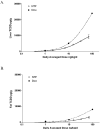Comparison of chronic toxicity and carcinogenicity of 2,3,7,8-tetrachlorodibenzo-p-dioxin (TCDD) in 2-year bioassays in female Sprague-Dawley rats
- PMID: 16977594
- PMCID: PMC1934421
- DOI: 10.1002/mnfr.200600031
Comparison of chronic toxicity and carcinogenicity of 2,3,7,8-tetrachlorodibenzo-p-dioxin (TCDD) in 2-year bioassays in female Sprague-Dawley rats
Abstract
The cancer bioassay for 2,3,7,8-tetrachlorodibenzo-p-dioxin (TCDD) conducted by the Dow Chemical company in the mid 70s has been used extensively for conducting quantitative cancer risk assessments for human exposure to TCDD. More recently the National Toxicology Program (NTP) conducted a cancer bioassay of similar design as part of its evaluation of the dioxin toxic equivalency factor methodology. This report compares the design and the results of these two cancer bioassays. This comparison confirms, in most cases, previously published and widely used carcinogenic response characteristics with respect to dose, time course, organ selectivity, tumor type and maximum intensity of TCDD-induced carcinogenicity and toxicity in the Sprague-Dawley rat. Specifically, increases in the incidences of neoplasms were seen in both studies in the liver, lung and oral mucosa. The most notable difference was the significant increase in the incidence of cholangiocarcinoma of the liver seen in the NTP study but not in the Dow study. The experimental designs for the two studies are similar but some protocol parameters differed, such as vehicle, dosing schedule, diet and rat sub-strain utilized. Differences in the shapes of the dose response curves for several neoplasms were noted between the studies, with the NTP study showing non-linearity for all neoplasms. This may result from differences in the experimental protocols as well as divergence in the biological behavior of the different stocks of Sprague-Dawley rat strains used.
Figures


Similar articles
-
NTP technical report on the toxicology and carcinogenesis studies of 2,3,7,8-tetrachlorodibenzo-p-dioxin (TCDD) (CAS No. 1746-01-6) in female Harlan Sprague-Dawley rats (Gavage Studies).Natl Toxicol Program Tech Rep Ser. 2006 Apr;(521):4-232. Natl Toxicol Program Tech Rep Ser. 2006. PMID: 16835633
-
NTP toxicology and carcinogenesis studies of 3,3',4,4',5-pentachlorobiphenyl (PCB 126) (CAS No. 57465-28-8) in female Harlan Sprague-Dawley rats (Gavage Studies).Natl Toxicol Program Tech Rep Ser. 2006 Jan;(520):4-246. Natl Toxicol Program Tech Rep Ser. 2006. PMID: 16628245
-
Toxicology and carcinogenesis studies of a mixture of 2,3,7,8-tetrachlorodibenzo-p-dioxin (TCDD) (Cas No. 1746-01-6), 2,3,4,7,8-pentachlorodibenzofuran (PeCDF) (Cas No. 57117-31-4), and 3,3',4,4',5-pentachlorobiphenyl (PCB 126) (Cas No. 57465-28-8) in female Harlan Sprague-Dawley rats (gavage studies).Natl Toxicol Program Tech Rep Ser. 2006 Sep;(526):1-180. Natl Toxicol Program Tech Rep Ser. 2006. PMID: 17342195
-
Carcinogenicity of 2,3,7,8-tetrachlorodibenzo-p-dioxin in experimental models.Mol Nutr Food Res. 2006 Oct;50(10):897-907. doi: 10.1002/mnfr.200600006. Mol Nutr Food Res. 2006. PMID: 16977593 Review.
-
NTP Research Report on the CLARITY-BPA Core Study: A Perinatal and Chronic Extended-Dose-Range Study of Bisphenol A in Rats: Research Report 9 [Internet].Research Triangle Park (NC): National Toxicology Program; 2018 Sep. Research Triangle Park (NC): National Toxicology Program; 2018 Sep. PMID: 31305969 Free Books & Documents. Review.
Cited by
-
The Role of the Aryl Hydrocarbon Receptor (AhR) and Its Ligands in Breast Cancer.Cancers (Basel). 2022 Nov 14;14(22):5574. doi: 10.3390/cancers14225574. Cancers (Basel). 2022. PMID: 36428667 Free PMC article. Review.
-
Risk for animal and human health related to the presence of dioxins and dioxin-like PCBs in feed and food.EFSA J. 2018 Nov 20;16(11):e05333. doi: 10.2903/j.efsa.2018.5333. eCollection 2018 Nov. EFSA J. 2018. PMID: 32625737 Free PMC article.
-
2,3,7,8-Tetrachlorodibenzo-p-dioxin (TCDD) alters hepatic polyunsaturated fatty acid metabolism and eicosanoid biosynthesis in female Sprague-Dawley rats.Toxicol Appl Pharmacol. 2020 Jul 1;398:115034. doi: 10.1016/j.taap.2020.115034. Epub 2020 May 5. Toxicol Appl Pharmacol. 2020. PMID: 32387183 Free PMC article.
-
The Aryl Hydrocarbon Receptor (AhR) as a Drug Target for Cancer Chemotherapy.Curr Opin Toxicol. 2017 Feb;2:24-29. doi: 10.1016/j.cotox.2017.01.012. Epub 2017 Feb 1. Curr Opin Toxicol. 2017. PMID: 28459113 Free PMC article.
-
Recent advances in 2D and 3D in vitro systems using primary hepatocytes, alternative hepatocyte sources and non-parenchymal liver cells and their use in investigating mechanisms of hepatotoxicity, cell signaling and ADME.Arch Toxicol. 2013 Aug;87(8):1315-530. doi: 10.1007/s00204-013-1078-5. Epub 2013 Aug 23. Arch Toxicol. 2013. PMID: 23974980 Free PMC article. Review.
References
Publication types
MeSH terms
Substances
Grants and funding
LinkOut - more resources
Full Text Sources


